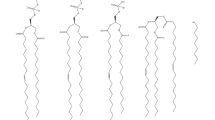Summary
Distribution of antibiotics can be described by kinetic hysteresis analysis when concentrations are measured in the serum and an extravascular sampling site. By calculating the area of the hysteresis loop (a simple formula is presented), the relative amount of drug transferred to an extravascular site can be quantified.
With this approach, changes in disposition characteristics can be evaluated under various pathophysiological conditions. In addition, a specific distribution coefficient may be derived for any drug when different dose levels are studied under identical conditions.
Kinetic hysteresis analysis overcomes the drawback of conventional compartment model pharmacokinetic analysis, since no simultaneous fitting of two different concentration-time courses is feasible.
Similar content being viewed by others
References
Bergan T (1978) Kinetics of tissue penetration. Scand J Infect Dis 14 [Suppl]: 36–46
Bondi JV, Tanner RD (1985) Kinetic hysteresis as a tool for analysis of pharmacokinetic data. In: Smolen VF, Ball L (eds) Controlled drug bioavailability, vol. I, Wiley & Sons, Chichester, pp. 177–202
Dost FH (1968) Grundlagen der Pharmakokinetik. Thieme, Stuttgart
Duschek A (1965) Vorlesungen über höhere Mathematik, vol. I, Springer, Wien New York
Flessner MF, Dedrick RL, Schultz JS (1984) A distributed model of peritoneal-plasma transport: theoretical considerations. Am J Physiol 246: R597-R607
Ganzinger U, Haslberger A (1985) Pharmacokinetics of cephalosporins in normal and septicaemic rabbits. Antimicrob Agents Chemother 28:473–477
Ganzinger U, Haslberger A, Schiel H, Omilian-Rosso R, Schütze E (1986a) Influence of endotoxin on the distribution of cephalosporins in rabbits. J Antimicrob Chemother 17:785–793
Ganzinger U, Schiel H, Georgopoulos A, Gumhold G (1986b) The utility of diffusion chambers as models for the description of drug disposition. J Antimicrob Chemother 18:93–102
Ganzinger U (1987) Distribution properties of cephalosporin in man: pharmacokinetic and experimental approaches. Int J Clin Pharmacol Ther Toxicol 25: 262–278
Gomeni R (1984) PHARM - an interactive graphic program for individual and population pharmacokinetic parameter estimation. Comp Biol Med 14:25–34
Haslberger A, Ganzinger U, Reiter H, Schiel H, Millendorfer A (1987) Alterations of pharmacokinetic properties of gentamicin, penicillin G and two cephalosporins in septicaemic rabbits. J Antimicrob Chemother 20:273–282
Holford NHG, Sheiner LB (1981) Understanding the dose-effect relationship: clinical application of pharmacokinetic-pharmacodynamic models. Clin Pharmacokinet 6:429–453
Jackquez JA, Bellman R, Kalaba R (1960) Some mathematical aspects of chemotherapy. II. The distribution of a drug in the body. Bull Math Biol 22: 309–322
Jusko WJ, Lewis GP, Dittert LW (1972) Integral coefficients of multicompartment pharmacokinetic models. Chemotherapy 17: 109–120
Jusko WJ (1980) Guidelines for collection and pharmacokinetic analysis of drug disposition data. In: Evans WE, Jusko WJ (eds) Applied Pharmacokinetics. Applied Therapeutics, Inc. San Francisco, pp 639–680
Loomis LH, Sternberg S (1968) Advanced Calculus. Addison Wesley, Reading
Ryan DM, Cars O, Hoffstedt B (1986) The use of antibiotic serum levels to predict concentrations in tissues. Scand J Infect Dis 18: 381–388
Sabath LD (1978) Tissue penetration of antibiotics, an overview. Scand J Infect Dis 14 [Suppl]: 313–315
Sheiner LB (1985) Modeling pharmacodynamics: parametric and nonparametric approaches. In: Rowland M, Sheiner LB, Steimer JL (eds) Variability in drug therapy: description, estimation, and control. Raven Press, New York, pp 139–152
Steimer JL, Mallet A, Mentre F (1985) Estimating interindividual pharmacokinetic variability. In: Rowland M, Sheiner LB, Steimer JL (eds) Variability and drug therapy: description, estimation, and control. Raven Press, New York, pp 65–109
Verotta D, Beal SL, Sheiner LB (1989) Semiparametric approach to pharmacokinetic-pharmcodynamic data. Am J Physiol 256: R10005-R10010
Westphal WH (1963) Physik. Springer, Berlin, Göttingen, Heidelberg
Wise R (1986) Methods for evaluating the penetration ofβ-lactam antibiotics into tissue. Rev Infect Dis 8 [Suppl 3]: 5325–332
Author information
Authors and Affiliations
Rights and permissions
About this article
Cite this article
Ganzinger, U., Neumann, K. Quantification of tissue distribution of antibiotics by kinetic hysteresis analysis. Eur J Clin Pharmacol 43, 517–522 (1992). https://doi.org/10.1007/BF02285094
Received:
Accepted:
Issue Date:
DOI: https://doi.org/10.1007/BF02285094




